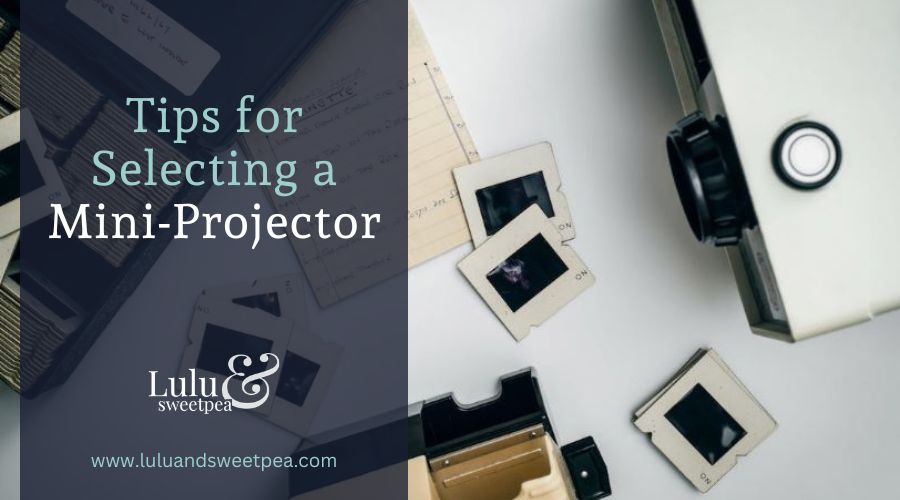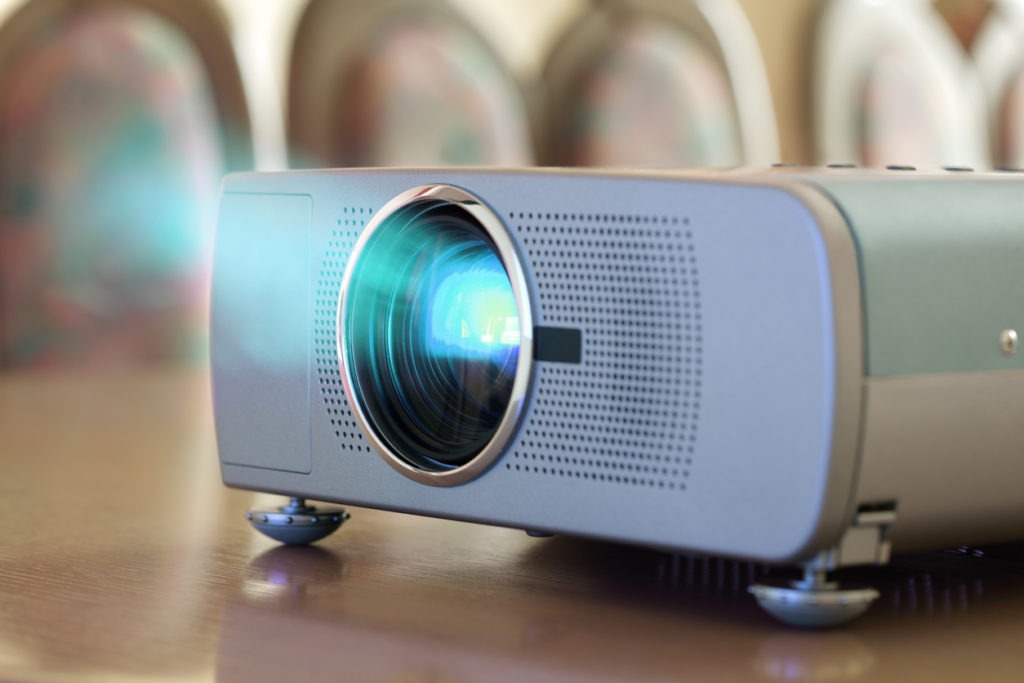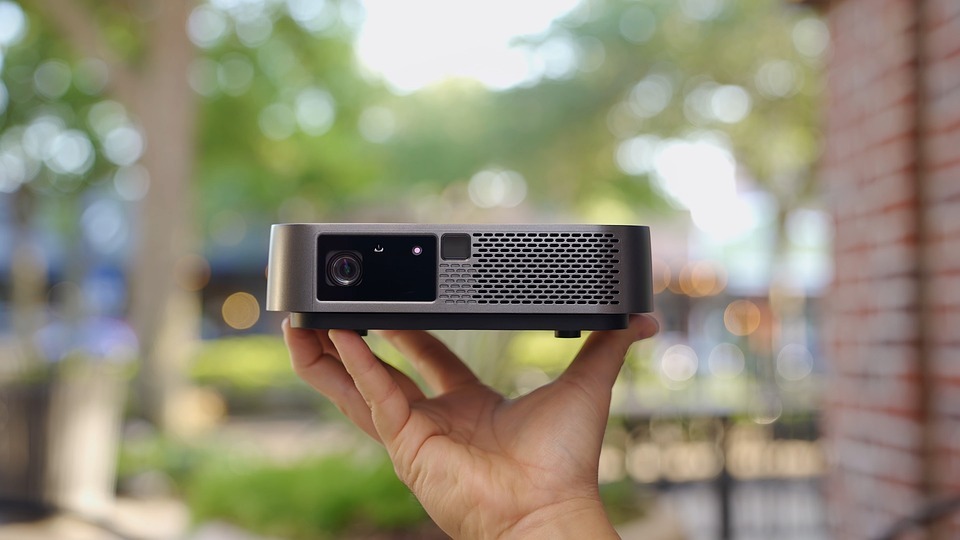Mini projectors have begun to proliferate throughout the market. With far lower pricing than their usual full-size equivalents, these projectors are handier and portable, allowing you to take them outdoors or share them with friends. Many of them feature wireless streaming capabilities, making them excellent for watching movies and television series. However, not every small projector is the same. You’ll discover that image quality and brightness are sacrificed significantly on the more affordable models.
Purchasing a new tiny portable projector necessitates an understanding of numerous crucial specifications. Let’s discuss the two distinct technologies that power all tiny projectors as well as the top three characteristics you will likely require.
What is a portable projector?
A tiny projector is often no larger than 8 inches by 8 inches by 4 inches. Typically, they do not have a designated location, and any included mount is typically a stand. These projectors are intended for usage on the fly with any semi-solid flat surface as the screen and do not require as much adjustment and precision as mounted projectors.
Compared to standard projectors, it can be difficult to perceive the actual value of smaller projectors, but they are ideal for a variety of applications. In the event of a tight budget, several high-end alternatives can be substituted for cheap or low-end full-size projectors.
They may not produce a sharp image, but they should be sufficiently bright, big, and battery-efficient for classes and conference rooms of average size.
Important Considerations Prior to Purchasing a Mini Projector
Projectors may transform even minor events into significant ones. Whether you are purchasing it for personal or professional usage, it is essential to select one that exceeds your expectations.
Mini projectors appear nearly identical at first glance; however, their characteristics might vary significantly. Therefore, to acquire the best offer, it is best to conduct research. This buying guide for tiny projectors is the result of our investigation into the factors that should be taken into account. To obtain a detailed perspective, look forward:
1. Contrast Ratio
In simple terms, the difference between the dark and light parts of a screen is called the contrast ratio. To determine this value, the luminance of the darkest and brightest portions is compared. This ratio is modified by a number of variables, including screen quality and ambient light. Nonetheless, novices should seek out a product with a better contrast ratio. A contrast ratio of 1000:1 or more is regarded as optimal.
2. Resolution
Projectors, like cameras, utilize the term “resolution” to describe their image quality. A photograph with a higher resolution will be crisp, clear, and accurate. Find a projector with a better resolution if you intend to project graphs, charts, and videos. A small projector with a resolution of at least 854 by 480 pixels is considered acceptable. Although it is not nearly full HD, playback is excellent. Therefore, seek resolution at or above this barrier.
3. Usefulness
Initial projector setup might be difficult and may require technical support. Thankfully, portable projectors make installation easier than ever before. In addition to the normal HDMI port, a projector with wireless capability can make your life much easier. Ensure it offers a higher bandwidth to decrease lag while wirelessly projecting your screens.
Moreover, projectors powered by full-featured operating systems, such as Android, can be a significant advantage. It simply permits a multitude of settings and facilitates the introduction of new features and hot fixes via software upgrades.
4. Distance and position of the throw
The throw distances supported by a projector are throw, short-throw, and ultra-short-throw. The throw distance of mini projectors can be either short or ultra-short.
While short-throw permits positioning between 3 and 8 feet (for a full image). The ultra-short throw distance is 0 to 4 feet, making it ideal for table projection. We recommend selecting a throw with a shorter length for rooms of adequate size.
5. Brilliance
The level of brightness required depends on the room in which you are projecting. When projecting in larger spaces with windows and better light, for instance, greater lumens are required. However, 150 ANSI lumens of brightness is sufficient for working in dark and even dimly lit rooms.
6. Battery Capability
The purpose of purchasing a tiny projector is to have a portable device. And portability is accompanied by a strong internal battery. Ensure that the projector you purchase can project at least a complete movie without recharging. So that you are not constantly have to carry the charging equipment.
7. Connections
It is imperative to consider how you will connect a portable projector to the devices you intend to utilize it with. If you wish to connect a laptop or a streaming device like a Roku or Apple TV, you will require an HDMI port and an HDMI cable. Numerous portable projectors include Wi-Fi and/or Bluetooth connectivity, which is ideal for wirelessly connecting your computer or phone. This enables the usage of any built-in streaming applications, including YouTube, Netflix, and Hulu.
8. Source of Power and Sound
Power source is a significant portability aspect. Many projectors on the market are equipped with rechargeable batteries that last between 2.5 and 4 hours and can be used while charging. Most portable projectors include built-in speakers and audio outputs that allow you to connect external speakers, and Bluetooth-enabled projectors can often function with wireless speakers.
What distinguishes mini projectors from standard projectors?
Mini-projectors are able to produce sharp, crisp images, but they cannot compete with larger, more powerful ones for several reasons. Larger projectors typically have more area for finely-tuned technology and inner components that contribute to the generation of higher-quality images, but they also have larger fans, which might cause them to be noisier, as we’ve previously discussed.
For example, larger projects typically have brighter lights and LED components, allowing them to project an image considerably further and with greater force. Additionally, they are known for being easier on the eyes, as we described in our prior guide. There may be some overlap in the specifications of high-end tiny projectors and inexpensive standard projectors, but the average full-size projector will generate a projection of superior quality, but not 3D visuals.
We are aware that small projectors cannot create images of the same size and quality as standard projectors, but they differ in other ways. Depending on the quality of the model, tiny projectors can be purchased for between $50 and $500, on average.
Mini projectors typically include a rechargeable battery, and their smaller, lighter bodies make them easier to transport and use on the go. However, this limits how long you can use the gadget without interruption, and the limiting of internal components frequently results in a dimmer, less contrasty image.
They are designed for simple connection and disconnection, as well as the efficient exchange of essential information. However, the compromise in size results in a sacrifice in quality due to fewer inputs and inferior components.
Conclusion
Choosing a tiny projector comes down to personal preference, requirements, and, of course, price. Think about the device you’ll be using to stream the information, the desired image size, and your budget.



